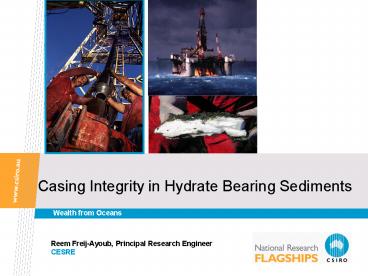Casing Integrity in Hydrate Bearing Sediments PowerPoint PPT Presentation
1 / 22
Title: Casing Integrity in Hydrate Bearing Sediments
1
Casing Integrity in Hydrate Bearing Sediments
Wealth from Oceans
- Reem Freij-Ayoub, Principal Research Engineer
- CESRE
2
Well integrity in hydrate bearing sediments (HBS)
JIP sponsors
Shell Global Solutions
3
Outline
- What are gas hydrates
- Possible drilling and well completion problems
- The model
- The dissociation algorithm
- Cases studied
- Results
- Conclusions/Future work
4
Gas hydrates
- Ice-like structures composed of water and natural
gas molecules - Under conditions of high pressure and low
temperature, water molecules form cages which
encapsulate gas molecules inside a
hydrogen-bonded solid lattice - Large gas storage capacity1 volume of gas
hydrate contains up to 180 volumes of gas at stp
5
Drilling and well completion problems
Hole enlargement
Casing collapse
Gas hydrate-related drilling problems (Adapted
from Maurer Engineering, Inc.)
Gas hydrate-related casing problems (Adapted from
Maurer Engineering, Inc.)
Hydrate dissociation? Gas release (gasified
mud) ? Loss of cohesion
6
Model
- Casing heating
- During drilling of lower sections of the wellbore
or - During production
7
Dissociation algorithm
Porosity
F current porosity Fo initial porosity Vc
volume of the Structure I crystal
Pore Pressure
8
Strength degradation with hydrate dissociation
Friction angle
porosity in percent ().
UCS, cohesion, tensile strength
C is cohesion in MPa UCS is unconfined
compressive strength in MPa F is angle of
internal friction in degrees (o) is
tensile strength in MPa
Tan et al. (2005)
9
Well integrity in HBS
Geomechanical strength-petrophysical correlations
Hydrate dissociation strength degradation
algorithm
In situ stress PP formation, cement casing
strength
Heat transfer into the formation
10
Model and cases studied
Cases studied-Symbol Cement Strength Hydrates
Case 1 strong cement and no hydrates in sediments (S-NH). strong no
Case 2 weak cement and no hydrates in sediments (W-NH). weak no
Case 3 strong cement with hydrate bearing sediments (S-H). strong yes
Case 4 weak cement with hydrate bearing sediments (W-H). weak yes
11
Formation properties
Parameter Value
Biots coefficient 1.0
Sediment porosity 0.25
Sediment porosity of the middle layer after hydrate dissociation 0.4
Thermal conductivity 1.4 Wm-1K-1
Specific heat capacity 1.9 x103 JK-1kg-1
Linear thermal expansion coefficient of hydrates 7.7x10-5 K-1
Linear thermal expansion coefficient of pore fluid 30x10-5?K-1
sediment solid dry density 2.800 kgm-3
Water density 1030 kgm-3
Modulus of Elasticity of sediments 807.6 MPa
Poissons ratio 0.35
Cohesion 1.7 MPA
Angle of internal friction 33.17º
Tensile strength 0.53 MPa
Water depth 800 m
Top level of hydrate layer below seabed 20 m
Bottom level of hydrate layer below seabed 60 m
In-situ temperature 15 ºC (288 K)
Gas constant 8.31441 JK-1Mol-1
Hydrates crystal volume 1.728x10-27 m3
Avogadro number 6.02205x1023
In situ stress ratio 1
12
Cement and casing properties
Parameter Value
Casing properties
Linear thermal expansion coefficient of steel 37x10-7?K-1
Thermal conductivity 1.4 Wm-1K-1
Casing thickness 0.635in
Casing Poissons ratio 0.3
Youngs modulus of steel 210 GPa
Casing yield stress 379 MPa
Casing external diameter 20 in
Cement-casing bond properties
Coupling spring tensile strength limit 1x1020 MPa
Coupling spring cohesion limit 1x1020 MPa
Coupling spring friction angle 0º
Initial temperature 3 ºC (288 K)
Casing raised temperature 33 ºC (298 K)
Casing density 7.85 x103 kg m-3
Casing top axial load 1.37 million Pound Force
Cement thermal properties
Thermal conductivity 0.66 Wm-1K-1
Specific heat 1.9x103 JK-1kg-1
Thermal expansion 7.7x10-5 K-1
Strong cement
Modulus of elasticity 55.16 GPa
Poissons ratio 0.4
cohesion 11.4 MPa
Friction angle 10º
Tensile strength 2.6 MPa
Weak cement
Modulus of elasticity 807.6 MPa
Poissons ratio 0.35
Cohesion 1.7 MPa.
Friction angle 10º
Tensile strength 0.53 MPa
13
Von Mises stress
at t0
14
Maximum von Mises stress
15
Ellipse of plasticity
16
Thrust
The profile of the thrust (normal force per
linear meter of casing length) along the casing
for the case of strong cement, and hydrates in
the sediments, tension positive compression
negative. The combined effect of heating the
casing and the dissociation of hydrates creates
compressive normal forces in the casing at the
interval where hydrates exist.
17
Maximum thrust
The absolute maximum thrust (hoop stress) in the
casing decreases with heating. This maximum
thrust occurs at the top of the casing for all
the cases studied and is detected close to the
base of the hydrate layer in case of its presence
after 4 days of heating. No risk of hydrostatic
buckling is found.
18
Seabed subsidence or heave
Before heating
After heating
19
Formation yield
Maximum yield radius
Before heating
Location of maximum yield radius
After heating
20
Conclusion
- In the scenario considered the casing remains
safe. - The main impact of heating the casing and
dissociating the hydrates was on the formation
integrity. - It is necessary to consider fluid flow (one or
two phase flow) and its impact on reducing the
pressure on the casing. This requires certain
assumptions about the permeability of the cement
and whether it will serve as a flow channel or
not. Such a model should also allow for the
reformation of hydrates. - The accurate consideration of fluid flow requires
modelling crack growth which can be done in a
discrete modelling code. - It is important to examine the effects of the
depth-proximity to seabed- and thickness of the
hydrate layer.
21
Future work
- Model Fault reactivation and flow through faults
using ABAQUS
22
(No Transcript)

